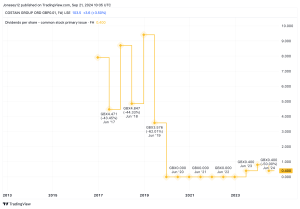Reaching the £10,000 mark is a key milestone for many savers. It’s a huge achievement, but a sizeable nest egg brings dilemmas. Getting the best bang for your buck is an important consideration. After all, it’s possible to turn this sum into a chunky passive income stream with savvy investments.
Cash savings accounts have merits. They’re much less volatile than dividend shares. However, potential stock market returns can be considerably higher. Investors who are prepared to embrace the risks could be handsomely rewarded.
Here’s how I’d target nearly £500 in monthly passive income from a dividend portfolio with £10k spare to invest.
Keep up the good work
Building a five-figure savings pot requires dedication. It’s a great starting point but it’s also worth keeping those savings practices up.
I’d start by investing the £10k lump sum, but I’d also set aside extra sums from my salary each month to invest. In doing so, I’m maximising my chances of hitting my passive income goals.
The share prices of my stocks can fall. By investing throughout the economic cycle, I’m buying in good times and in bad, hopefully scooping up cheap bargains along the way.
Dividend investing
I use several metrics to assess whether I’d like to buy a particular dividend stock. These include the dividend yield, distribution history, dividend cover, valuation, and potential for share price growth.
To illustrate this in practice, one FTSE 250 stock that I think is worth considering is Pets at Home Group (LSE:PETS). Britain’s a nation of pet lovers and this retailer’s a prominent player in the market.
The company’s product portfolio spans toys, accessories, bedding, and medication for our furry friends. It also offers services from veterinary to grooming.
For starters, the yield looks attractive. At 4.2%, it beats the average for the FTSE 100 and FTSE 250. In addition, an ongoing £25m share buyback programme adds value for shareholders.
The firm’s dividend history is also appealing. Payouts have grown considerably since 2015 and investors have earned regular passive income over the past nine years.
Dividend cover is respectable at 1.6 times earnings. Granted, this is below the two-times level that indicates a wide margin of safety. However, it’s above a ratio of 1.5. Below this threshold is generally where I’d have serious concerns.
Regarding the valuation, a forward price-to-earnings (P/E) ratio of 13.8 also looks reasonable. So far, so good then.
One red flag for me is the growth potential. A Competition and Markets Authority (CMA) investigation into the vet industry is damaging investor confidence. That said, the group’s recent trading update showed resilient revenue growth in Q1, but regulatory risks shouldn’t be overlooked.
Overall though, I think there’s a solid investment case for this dividend stock.
Compound returns
By investing in a diversified mix of shares like Pets at Home, I could make £499 in monthly passive income in just over 25 years with modest contributions.
Assuming my portfolio grew at 7% a year and I secured a 5% yield across my holdings, I’d hit my target by investing £10k plus an extra £83 per month.
Dividends aren’t guaranteed so it’s not a risk-free endeavour. But, it doesn’t take a fortune to earn a healthy passive income if all goes to plan.
This post was originally published on Motley Fool







